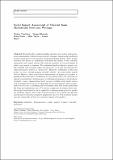Social impact assessment of scientist from mainstream news and weblogs
Date
2017-10-14Author
Timilsina, Mohan
Khawaja, Waqas
Davis, Brian
Taylor, Mike
Hayes, Conor
Metadata
Show full item recordUsage
This item's downloads: 937 (view details)
Cited 7 times in Scopus (view citations)
Recommended Citation
Timilsina, Mohan, Khawaja, Waqas, Davis, Brian, Taylor, Mike, & Hayes, Conor. (2017). Social impact assessment of scientist from mainstream news and weblogs. Social Network Analysis and Mining, 7(1), 48. doi: 10.1007/s13278-017-0466-x
Published Version
Abstract
Research policy makers, funding agencies, universities and government organizations evaluate research output or impact based on the traditional citation count, peer review, h-index and journal impact factors. These impact measures also known as bibliometric indicators are limited to the academic community and cannot provide the broad perspective of research impact in public, government or business. The understanding that scholarly impact outside scientific and academic sphere has given rise to an area of scientometrics called alternative metrics or “altmetrics.” Moreover, researchers in this area incline to center around gauging scientific activity via social media, namely Twitter. However, these count-based measurements of impact are sensitive to gaming as they lack concrete references to the primary source. In this work, we expand a conventional citation graph to a heterogeneous graph of publications, scientists, venues, organizations based on more reliable social media sources such as mainstream news and weblogs. Our method is composed of two components: the first one is combining the bibliometric data with social media data like blogs and mainstream news. The second component investigates how standard graph-based metrics can be applied to a heterogeneous graph to predict the academic impact. Our result showed moderate correlations and positive associations between the computed graph-based metrics with academic impact and also reasonably predict the academic impact of researchers.


